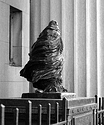Ed, IMHO it is inappropriate to speak of reflections deep within the barrel in the same context as reflections that you can get between the filter and front element. The front element sees way more light than actually forms the image.... that's why we hood...
Anyway, there are good reasons why doublets are cemented and not air spaced.... but this is really beside the point. Again, the stray light at (and beyond) the front element is the issue here.
People just need to do what works for them, and if they do offer an opinion, they should back it up as transparently as possible! I have stated my reasoning very clearly ( I think): a filter, no matter how multicoated and German, introduces two extra surfaces in front of the front element. That's it! Either that means something to you or it doesn't! And you probably don't want to see a detailed ray diagram to demonstrate what I am saying, so let's just let it go

Part (b) of this logic is that filters are not considered in the lens design... they could not be! That's because the thickness of the lens, the dispersion of the glass, the spacing form the front element etc. are all variables that you'd need to know in order to do it right. And lo! The filters are
-flat!-... not curved like the front element, so that calculation would be really dicey. Now, there are examples of filters that
are considered within the overall lens design: for example, the lenses with slip-in filter compartments within the barrel. You get a set of filters with the lens. But again, the front element is what sees a lot of extra stray, non-image-forming light.... etc.
There is one recent notable exception to this rule that lens designers don't like to see filters in their lenses. The leica m8 has the issue that they couldn't place a [IR-reflecting] hot mirror between the sensor and the rear element. so for that one camera, one is obligated to put a hot mirror over the front element to avoid purply blacks.... just because the digital sensor has extended IR sensitivity. Now, I don't know about you, but I'd be hopping mad if somebody told me I had to use a hot mirror over my front element. But anyway, that is the only example of which I am am aware that the factory actually suggested that a front filter could improve the image. And clearly it is a major compromise forced by the camera design itself.
I admit that I have a hard time considering the cost of a lens in this discussion. If we're talking about ways to promote the ultimate image quality, then the discussion is simpler: don't use filters unless absolutely necessary, and always hood. Simple. Indisputable. Count the interfaces.
If we start considering everyone's individual finances and how that influences the way they shoot, well then these discussions always go off in some meandering direction. Personally I don't understand the fear of using superfantastic lenses unfiltered because of what may happen if they are careless. That which you are afraid to use as the lens designers intended should be at home in the velvet box. Sorry to be blunt, but really.... (here we go! And this isn't without ample forewarning!)....
It doesn't cost anything to be careful.
---
Just be obnoxious, I'll just add one other curveball to this: sometimes you actually
want flare and such. Here is such a case, something I shot last autumn with an rb fisheye. Fisheye into the sun. Lotsa stray light and weird flare and such... and totally intentionally set up to pick up all those things, but... wait, there is an illustrative question after you look at the image...
(there was a url link here which no longer exists)
Now the question: how much of that do you think I was able to see on the ground glass?
.
.
.
.
.
Answer: almost none of it.
Thinkaboudit










